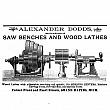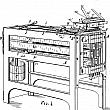Julius Berkey Discovers the Carving Machine
by Arthur S. White
During the Exposition held in Philadelphia in 1876, celebrating the one hundredth anniversary of the signing of the Declaration of Independence, Julius Berkey discovered a man named Clarke operating a small machine for the ornamentation of small pieces of ivory. Berkey’s mind was a practical one, and after watching Clarke at his work for a short time, engaged him in conversation.
While the delicate little machine Clarke had operated served his purpose in decorating ivory, it would not be strong enough for carving wood. In addition the cutters used were too small and were intended especially for intricate tracery and delicate line work. Berkey learned that Clarke had designed the machine and seemed to possess the skill and mechanical knowledge necessary to enable him to design a larger and stronger one.
Convinced that such a machine would be a valuable addition to the wood-working department of the Berkey & Gay Furniture Co., Berkey and Clarke entered into a contract at once, under the terms of which Clarke agreed to take up residence in Grand Rapids, after the close of the exposition, where he would supervise the construction of the tools necessary to install a machinery carving department in the factory of the company.
Clarke was so successful with the department that the managers of competing factories called upon the machinery builders to supply them with the tools required to produce machine-cut carving. C.O. and A.D. Porter were the first to respond to the demand with a bench machine that permitted the cutting of a wider range of work than the Clarke machine possessed.
Naturally, hand-carvers were engaged to operate the machines, and, although their capacity was then, and is still, limited to the cutting of plain lines to be finished by hand-cutters, the operation of the machine proved to be profitable mainly for the expedition with which goods could be put through the factories. Formerly shipments were often delayed because the hand-carvers failed to keep pace with the other departments.
Among the master carvers who are entitled to credit for assisting in bringing out the capacity of the machines were Louis Hahn, the commercial designer, formerly a foreman of hand-carvers in the employ of the Nelson-Matter Furniture Co.; Charley Conrad, for many years with Spencer & Barnes of Benton Harbor; and James A. Anderson of Grand Rapids, who learned to operate bench carvers and performed intricate and artistic work with the power-driven tools that many skillful carvers could not execute by hand.
DEVELOPMENT BY OTHER MANUFACTURERS
Alexander Dodds invented and patented a machine carver which, when installed was suspended from the ceiling of the room where it was to be operated. He sold quite a number of the machines, but the cost of manufacturing was so much larger than that of the Porter machine that the wood-workers did not care to pay the difference. The variation in the heights of the ceiling rendered it necessary to build to order the iron framework used in supporting the machine. An advantage claimed for the Dodds carver was that the operator was able to work under and around the cutters with perfect freedom.
S.L. King also built a suspension-carving machine with features of especial value. Quite a number were sold. He also invented and built the first stippling machine used in a furniture factory for the Muskegon Valley Furniture Co. Morris Wood, the founder of the house of Morris Wood & Sons, built a heavy bench carving machine that many wood-workers use for roughing-out or doing the preliminary work of fine carving.
The automatic carving machine brought out by Seaman of Milwaukee, Ledeman of St. Louis, Moore of Milwaukee, and later of Minneapolis, and others, came later, displacing in many instances the bench machines because of their larger capacity and in the variety of work they could perform. A few years ago the West Michigan Machine and Tool Company of Grand Rapids brought out a carving machined provided with a directly attached motor for driving it. Steadiness is an essential in the production of carvings by machinery and no means seemed available for preventing vibration. The belting running over the drive, with the ends joined by laces or metal clasps, produced vibrations that caused imperfections in the cutting. However, the motor attached directly to the machine eradicated this evil.
John Waddell, president of the Waddell Manufacturing Co., of Grand Rapids, and a very ingenious mechanic, early perceived the possibilities of development in wood carving machines. In his company shops quite a number of specially constructed machines are in use.
The old hand-carver, years ago, was an important individual in the woodworking industry, but it must be said to his credit that he aided largely in the development of the machines that have put many of his fellows out of the wood-carving shops.
Excerpted from Furniture Manufacturer and Artisan, May 1911, page 236

 facebook
facebook

